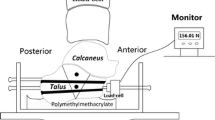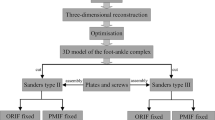Abstract
Calcaneal fractures are the most common fractures of the tarsal bones. The stability of fixation is an important factor for successful reconstruction of calcaneal fractures. The purpose of this study was to analyze the biomechanical influence of plate fixation with different combinations of locking and nonlocking screws during early weight-bearing phase. A three-dimensional FE foot model was established using ANSYS software, which comprised bones, cartilages, plantar fascia, and soft tissue. Calcaneal plate was fixed with whole locking (WLS), whole nonlocking (WNS), and hybrid screw configurations for FE analysis. The WNS generated a 6.1° and 2.2° Bohler angle decrease compared with the intact model and WLS (WNS: 18.9; WLS: 21.1; intact: 25.0°). Some hybrid screw configurations (Bohler angle: 21.5° and 21.2°) generated stability similar to WLS. The FE results showed that the fragments at the posterior facet and the posterior tuberosity sustained more stress. This study recommends that the hybrid screw configuration with at least four locking screws, two at the posterior facet fragment and two at the posterior tuberosity fragment, is the optimal choice for the fixation of Sanders type IIB calcaneal fractures.






Similar content being viewed by others
References
Blake MH, Owen JR, Sanford TS, Wayne JS, Adelaar RS (2011) Biomechanical evaluation of a locking and nonlocking reconstruction plate in an osteoporotic calcaneal fracture model. Foot Ankle Int 32:432–436
Brilakis E, Kaselouris E, Xypnitos F, Provatidis CG, Efstathopoulos N (2012) Effects of foot posture on fifth metatarsal fracture healing: a finite element study. J Foot Ankle Surg 51:720–728
Chapman J, Harrington R, Lee K, Anderson P, Tencer A, Kowalski D (1996) Factors affecting the pullout strength of cancellous bone screws. J Biomech Eng 118:391–398
Chen K, Zhang H, Wang G, Cheng Y, Qian Z, Yang H (2014) Comparison of nonlocking plates and locking plates for intraarticular calcaneal fracture. Foot Ankle Int 35:1298–1302
Chen W-M, Lee T, Lee PV-S, Lee JW, Lee S-J (2010) Effects of internal stress concentrations in plantar soft-tissue—a preliminary three-dimensional finite element analysis. Med Eng Phys 32:324–331
Cheung JT-M, An K-N, Zhang M (2006) Consequences of partial and total plantar fascia release: a finite element study. Foot Ankle Int 27:125–132
Coughlin MJ, Mann RA, Saltzman CL, Anderson RB (2007) Surgery of the foot and ankle. Mosby Inc, Philadelphia, PA
Hirschmüller A, Konstantinidis L, Baur H, Müller S, Mehlhorn A, Kontermann J, Grosse U, Südkamp N, Helwig P (2011) Do changes in dynamic plantar pressure distribution, strength capacity and postural control after intra-articular calcaneal fracture correlate with clinical and radiological outcome? Injury 42:1135–1143
Hsiao H, Guan J, Weatherly M (2002) Accuracy and precision of two in-shoe pressure measurement systems. Ergonomics 45:537–555
Hsu Y-C, Gung Y-W, Shih S-L, Feng C-K, Wei S-H, C-h Yu, Chen C-S (2008) Using an optimization approach to design an insole for lowering plantar fascia stress—a finite element study. Ann Biomed Eng 36:1345–1352
Hyer CF, Atway S, Berlet GC, Lee TH (2010) Early weight bearing of calcaneal fractures fixated with locked plates: a radiographic review. Foot Ankle Spec 3:320–323. doi:10.1177/1938640010374121
Illert T, Rammelt S, Drewes T, Grass R, Zwipp H (2011) Stability of locking and non-locking plates in an osteoporotic calcaneal fracture model. Foot Ankle Int 32:307–313
Isvilanonda V, Dengler E, Iaquinto JM, Sangeorzan BJ, Ledoux WR (2012) Finite element analysis of the foot: model validation and comparison between two common treatments of the clawed hallux deformity. Clin Biomech 27:837–844
Jastifer JR (2014) Topical review locking plate technology in foot and ankle surgery. Foot Ankle Int 35(5):512–518. doi:10.1177/1071100714523274
Kienast B, Gille J, Queitsch C, Kaiser M, Thietje R, Juergens C, Schulz A (2009) Early weight bearing of calcaneal fractures treated by intraoperative 3D-fluoroscopy and locked-screw plate fixation. Open Orthop J 3:69
Lemmon D, Shiang T, Hashmi A, Ulbrecht JS, Cavanagh PR (1997) The effect of insoles in therapeutic footwear—a finite element approach. J Biomech 30:615–620
Nakamura S, Crowninshield R, Cooper R (1980) An analysis of soft tissue loading in the foot—a preliminary report. Bull Prosthet Res 10:27–34
Pang Q-j YuX, Z-h Guo (2014) The sustentaculum tali screw fixation for the treatment of Sanders type II calcaneal fracture: a finite element analysis. Pak J Med Sci 30:1099
Pendergast M, Rusovici R (2015) A finite element parametric study of clavicle fixation plates. Int J Numer Methods Biomed Eng 31(6):e02710
Redfern DJ, Oliveira ML, Campbell JT, Belkoff SM (2006) A biomechanical comparison of locking and nonlocking plates for the fixation of calcaneal fractures. Foot Ankle Int 27:196–201
Richter M, Gosling T, Zech S, Allami M, Geerling J, Droste P, Krettek C (2005) A comparison of plates with and without locking screws in a calcaneal fracture model. Foot Ankle Int 26:309–319
Sangeorzan BJ, Ananthakrishnan D, Tencer AF (1995) Contact characteristics of the subtalar joint after a simulated calcaneus fracture. J Orthop Trauma 9:257–258
Schepers T, van Lieshout E, Van Ginhoven T, Heetveld M, Patka P (2008) Current concepts in the treatment of intra-articular calcaneal fractures: results of a nationwide survey. Int Orthop 32:711–715
Siegler S, Block J, Schneck CD (1988) The mechanical characteristics of the collateral ligaments of the human ankle joint. Foot Ankle Int 8:234–242
Simkin A (1982) Structural analysis of the human foot in standing posture. Tel-Aviv University, Tel-Aviv
Stoffel K, Booth G, Rohrl SM, Kuster M (2007) A comparison of conventional versus locking plates in intraarticular calcaneus fractures: a biomechanical study in human cadavers. Clin Biomech 22:100–105
Sun P-C, Shih S-L, Chen Y-L, Hsu Y-C, Yang R-C, Chen C-S (2012) Biomechanical analysis of foot with different foot arch heights: a finite element analysis. Comput Methods Biomech Biomedi Eng 15:563–569
Terrier A, Kochbeck S, Merlini F, Gortchacow M, Pioletti DP, Farron A (2010) Tightening force and torque of nonlocking screws in a reverse shoulder prosthesis. Clin Biomech 25:517–522
Wang Y, Li Z, Zhang M (2014) Biomechanical study of tarsometatarsal joint fusion using finite element analysis. Med Eng Phys 36:1394–1400
Wright D, Rennels D (1964) A study of the elastic properties of plantar fascia. J Bone Joint Surg Am 46:482–492
Acknowledgements
This study was supported partly by Taipei Veterans General Hospital (V104C-177) and by Ministry of Science and Technology, R.O.C. (MOST 104-2314-B-075-002).
Author information
Authors and Affiliations
Corresponding author
About this article
Cite this article
Chen, CH., Hung, C., Hsu, YC. et al. Biomechanical evaluation of reconstruction plates with locking, nonlocking, and hybrid screws configurations in calcaneal fracture: a finite element model study. Med Biol Eng Comput 55, 1799–1807 (2017). https://doi.org/10.1007/s11517-017-1623-0
Received:
Accepted:
Published:
Issue Date:
DOI: https://doi.org/10.1007/s11517-017-1623-0




